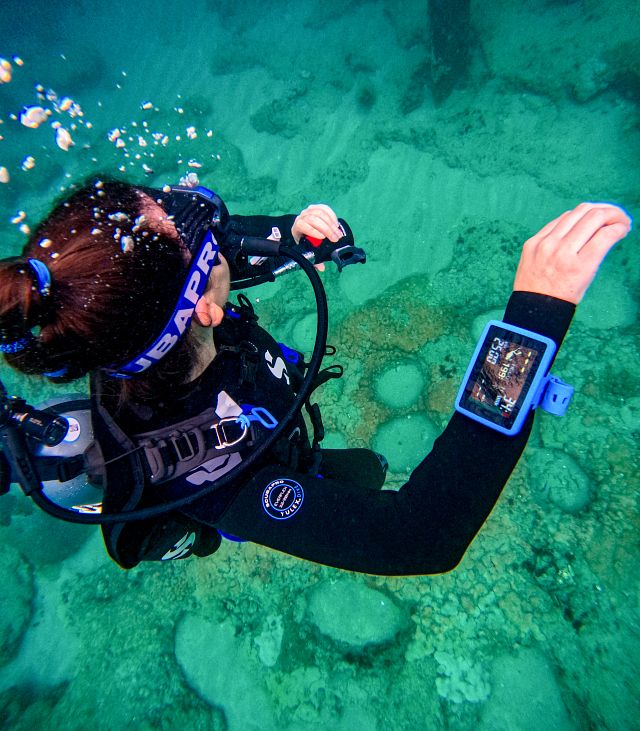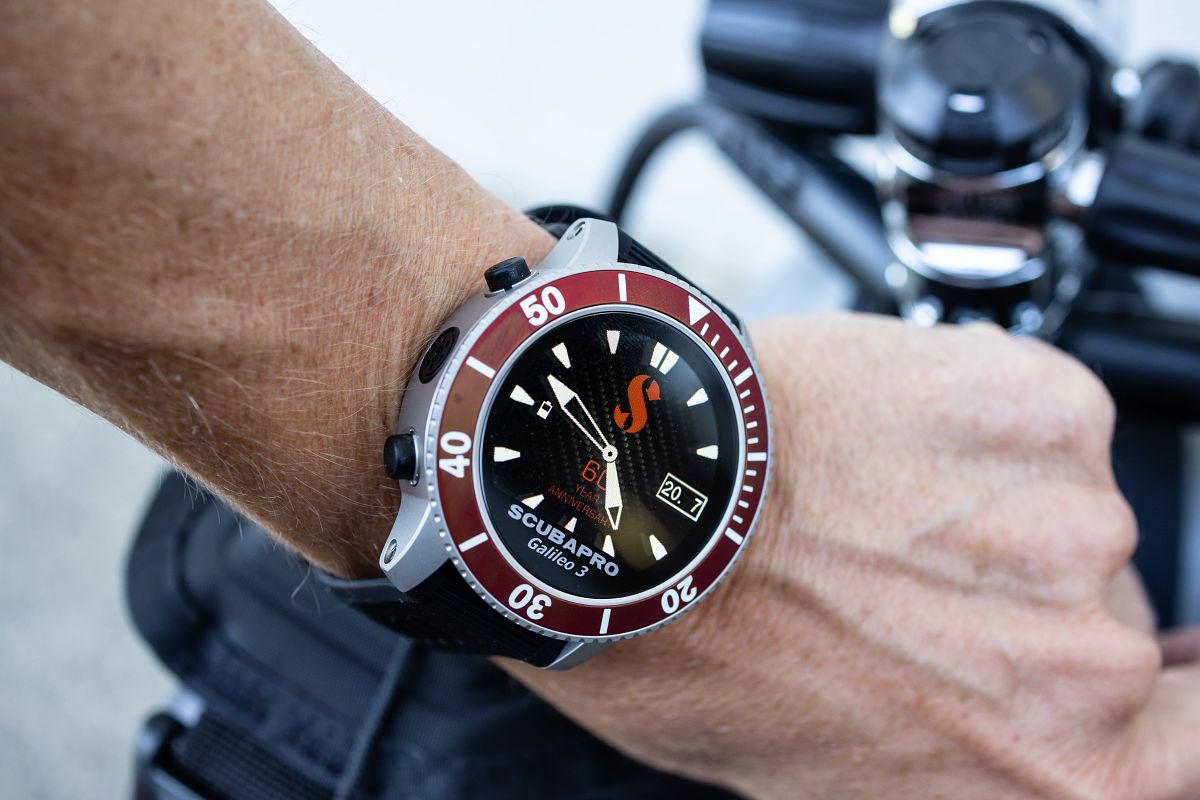Dive Watch vs. Dive Computer: What's the Difference?
When it comes to scuba diving gear, there are no two pieces of equipment more easily confused than dive watches and wrist-mount dive computers. While these two pieces of equipment can stylistically look very similar, the difference between a dive watch and a dive computer comes down to the data that's available.
Dive watches and dive computers are devices that provide timekeeping information for divers underwater at a glance. While not all dive computers are worn on the wrist – such as console computers and the Galileo HUD – wrist computers are preferred by many divers thanks to ease of use, readability, and reliable dive data.
While divers can track their dives using traditional dive tables, a depth gauge, and a dive watch – most divers opt for a Dive Computer to help simplify the tracking process, as well as gain in-depth insights for safer diving.
Dive computers, on the other hand, are an entirely different story. Thanks to innovations in technology, dive computers continue to provide more accurate dive data than ever before – all in a compact wristwatch-style package that can closely resemble a traditional dive watch.
Diving into Dive Watches and Dive Computers
In casual conversation, some divers may mistakenly use the terms "dive watch" and "dive computer" interchangeably, but they're actually two very different things in a scuba diver's gear kit.
The key difference between dive watches and dive computers is that dive computers are designed specifically for scuba divers to provide all critical dive data at a glance. Dive watches can only be used to track dives when paired with a depth gauge and traditional dive tables, and the key feature is their ability to withstand pressure and conditions at depth.
Dive computers, however, are much more complex pieces of machinery designed specifically for scuba diving. Today's dive-watch-sized computer operates a lot more like a smartphone or smart device, as it calculates depth, oxygen levels, ascent rate, bottom time, and so much more.

There are three primary styles of computers available to divers:
Types of Dive Computers:
What is a Dive Watch?
Dive watches are essentially that – a time-keeping device. When paired with Dive Tables and a Depth Gauge, Dive Watches can be used to track your dives with bare-bones information.
Although this may seem clear-cut, many new dive computers like the SCUBAPRO Galileo 3 (G3) resemble smartwatches made for topside use. These watch-sized dive computers are highly advanced in technology, but visually can easily be confused for a watch.
A dive watch is a timepiece designed for underwater use that features a water resistant case, and either no diving computer function or a rudimentary one. The hands of the watch are usually highly visible making them readable in low light conditions.
Very often they have a unidirectional bezel to prevent accidental resetting of the watch whilst under water. A standard dive watch must also be resistant to water, salt, shock, condensation and magnetism. Most dive watches show the time and employ a unidirectional rotating bezel to track duration of time in the water.
Dive watches can be either analog or digital, but these wristwatches only offer a limited amount of information. Generally, dive watches-including analog or digital-can still be worn by divers, though now they tend to be more of a fashion piece and a backup timekeeping device more than anything else. Many popular watch brands have a diver's model that consumers may buy for looks. Some choose to wear dive watches in their day-to-day lives as a signal to others that they are divers.
Dive Watch Pros and Cons
Divers won't consider buying a dive watch as an alternative to a dive computer, however you'll still want to consider the benefits and drawbacks of the technology.
Pros
- Redundancy is important when diving. If your dive computer goes out during a dive, having a watch as a back-up system can help you get back to the surface safely.
- When paired with Dive Tables and a Depth Gauge, dive watches can be used to teach divers how to manually calculate, track, and plan their dives – which can be incredibly valuable as a backup in the rare case of computer failure.
- Dive watches are designed to be durable and easy to use topside and at depth.
Cons
- Dive watches offer very limited information and require additional resources to aid in dive planning.
- Dive watches are not preferred by some SCUBA Diving Certification Organizations, even though many still teach divers how to use a dive watch, dive tables, and pressure gauge for dive planning
- The computerized algorithms offered in dive computers aren't available in the traditional watches, making diving harder and manual calculations a must.
What is a Dive Computer?

A dive computer is a device that calculates how long you can stay underwater for, depending on the depth to which you are diving. It replaces dive tables and compasses to calculate depth, bottom time, surface intervals, air mixes, direction, and even heart rate. It's essentially the equivalent of a smart watch for scuba diving. LED or OLED digital screens allow you to see complex information or interact with your data while underwater.
Dive computers are a unique category including wrist devices and other devices. Other advanced dive computers implement a Hands-Free Heads Up Display (HUD), attaching to your dive mask.
Wrist-mount and wristwatch-style dive computers give divers the opportunity to create a customized dive profile. Advanced tech that measures factors like heart rate, breathing workload, and skin temperature. Instead of using a dive watch, you can also use a straightforward digital dive computer to use as your backup to an advanced dive computer. Some dive wrist computers are shaped like a watch, while others are shaped like a smartphone with a strap.

Dive Computer Pros and Cons
With continued advances in technology and budget-friendly dive computers readily available, there are very few cons for divers when investing in a dive computer.
Pros
- Dive Computers are specifically designed for scuba divers to increase safety and bottom time by providing in-depth, highly accurate data
- Dive computers are much more accurate than traditional dive watches or tables. They track your dive to give you the most exact no-decompression time. This helps you to stay underwater as long as possible.
- Built-in dive logs. Modern dive computers often let you download your dive logs onto your home devices.
- A dive computer is compact and easy to bring with you. If you rent your gear at your destination because of luggage capacity, your computer will take up minimal space and something that you can always bring.
- Their technology monitors ascent speed with alarms, eliminating the ascent guessing game.
- Easy-to-use technology tracks everything you need for a successful dive, you'll just need to know how to correctly interpret the data.
- Divers spend more time underwater because dive computers can accurately track your profile than a dive table.
- Integrate air pressure into your dive computer readings, providing accurate remaining dive time left.
Cons
- Dive computers can be expensive. The initial investment may seem hefty for those who are just getting into diving.
- While easy to use, there can be a learning curve for divers. Be sure to familiarize yourself with all of its capabilities and go through the manual.
- Not all dive computers are made to provide advanced and technical dive data, so you may have to upgrade your computer as your training increases.
The Best Wrist Device for Divers
Because traditional dive watches won't cut it as your primary biometric device under the water, you'll want to invest in a more advanced dive computer, especially for longer or more complicated dives.
A dive computer will tell you everything that a dive watch does-and so much more, with the added data capabilities specific to the unique conditions scuba divers experience.
Traditional dive watches can still serve the purpose of a back-up time keeping device, but are no longer necessary pieces of scuba diving gear.
To have the best possible dive, use a dive computer to give you the best and most accurate information.






